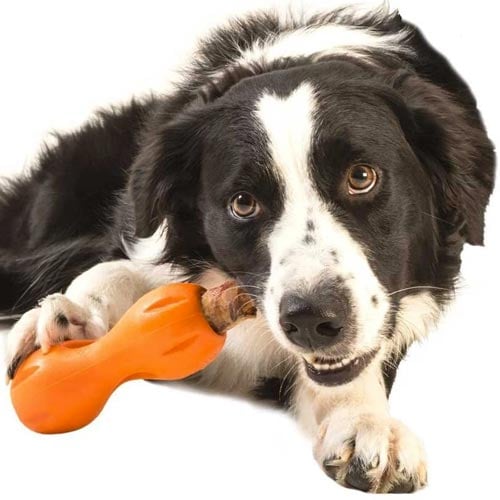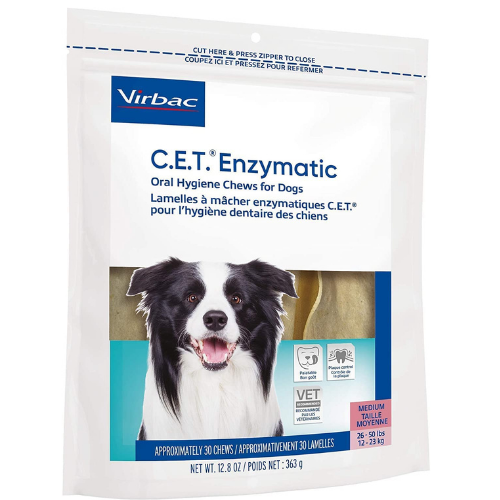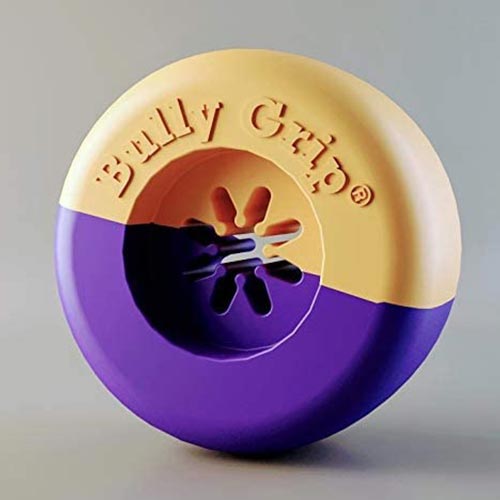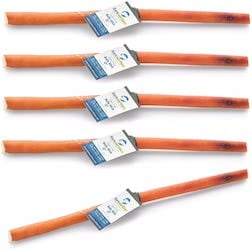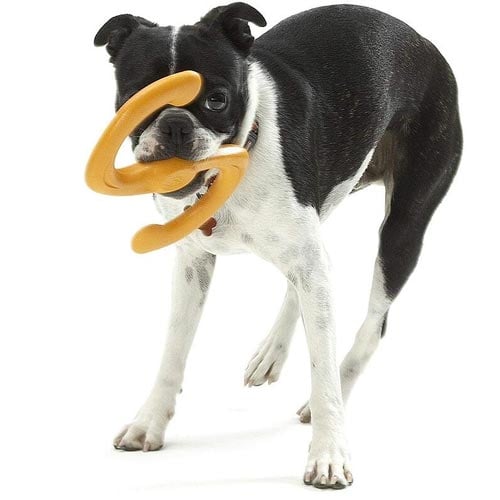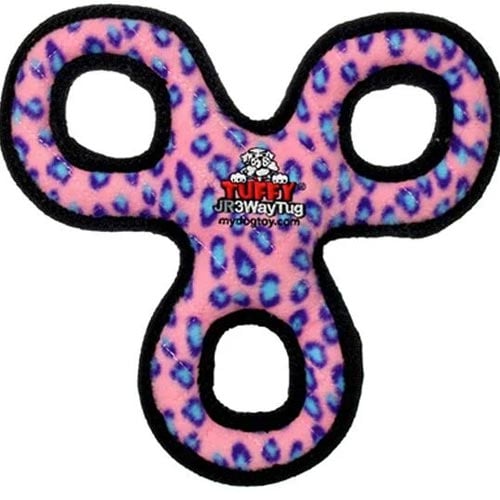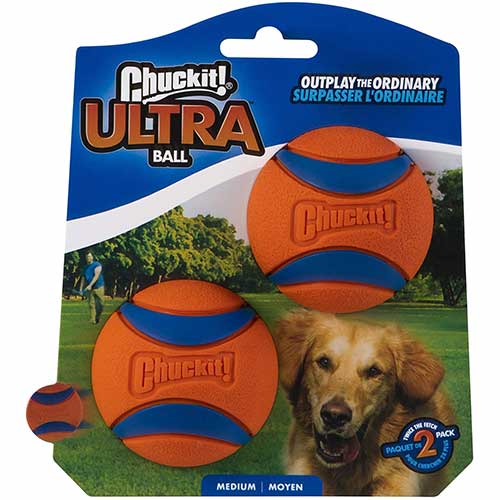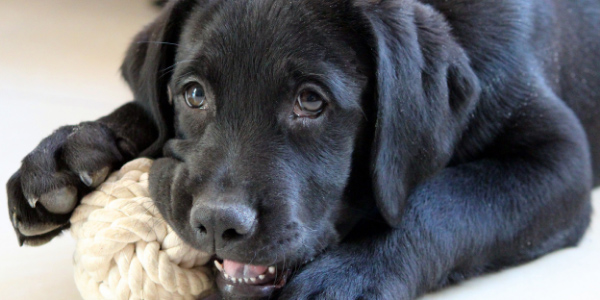
Chewing is an important part of our well-being. I mean, who doesn’t get comfort and joy from chewing?
Research in people suggests that chewing/biting benefits brain function, lowers stress and anxiety, regulates cognitive function, in particular attention, and naturally aids in the digestive process. So, if this is a natural behavior and beneficial for us, then it shouldn't be a surprise that it is natural and essential for our dogs.
Chewing is just a part of being a dog. And it’s quite an important part, too!
Whether they’re a puppy or an adult dog, all dogs need to chew. Puppies chew when they’re teething to relieve pain and soothe their gums or just to explore the new world (like a baby!). Then, they continue through adulthood to keep their masticatory (chewing) muscles strong, their teeth clean, and their brain engaged.
Chewing helps older dogs deal with anxiety, frustration, and boredom. In fact, it’s one of the three enrichment activities that help calm down a hyper or anxious dog. For humans, we can relate it to our desire to chew gum. Have you ever noticed that chewing gum makes you more alert and promotes a more positive mood and relaxation? If it can do that for us, chewing is certainly beneficial to our dogs. That is, as long as they are chewing on the right things.
Safe Chews: What You Should Know
3 Steps to Choose Safe Dog Chews
Pros & Cons of Different Chews
Rubber Chew Toys
Silicone Dog Chews
Edible Dog Chews
Rope Toys, Stuffed Toys, and Balls
How to Make Chew Toys Last
Safe Chew Toys: What You Should Know
Chewing is good for your dog’s mental and physical health, so it’s important that you provide them with plenty of safe and appropriate things to chew on. Fail to do so, and they’ll come up with their own chew “toys,” like your most expensive pair of shoes, the legs of your dining room chairs, the nearest electric cord, or even your arm!
There are a LOT of dog chews and chew toys available these days! Which ones are best? Which should you avoid? How do you choose? Are rope toys safe for dogs? Are nylabones bad for dogs? What about rawhides?
To help, we've put together this 3-step guide so you can "chews" wisely and safely. And, since no two dogs use a toy the exact same way (see the “Chewsonality” section below), we’ve also included a few words of caution about the different types of chews and chew toys so you can best assess which types might be best for your dog and so you can know what to look out for if any problems arise.
If you want to learn what types of dog chews to avoid, check out Potential Dangers of Popular Dog Chews.
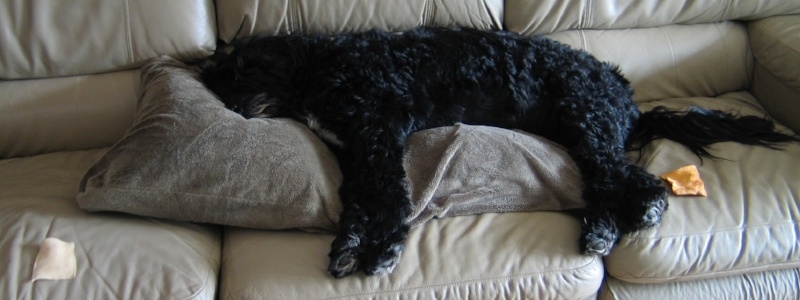
3 Simple Steps to Choose Your Dog's Chew Toys
Step 1: Figure Out Your Dog's Chewsonality and Chew Style
It doesn’t matter if you have a tea-cup-sized Chihuahua or a pony-sized Mastiff; all dogs generally have a desire and love for chewing. However, each dog has their own style of chewing. Before you go chew toy shopping, it's important to observe your dog and determine what type of chewer your dog is — their "chewsonality." Which one of these best describes your dog?
- INHALER: Now you see it, now you don't! Inhalers bite off large chunks of edible chews and swallow them fast — which is why they're also known as "Gulpers."
- DESTROYER: These are the dogs that try to (and often succeed in) thoroughly destroying whatever they get their mouths on! These dogs love to shred their chews and toys. They may or may not swallow what they destroy, so be careful because there can be some overlap between a "Destroyer" and an "Inhaler." And these hybrid chewers can certainly be very difficult to shop for!
- NIBBLER: These dogs are lovers, not fighters. They take their time and savor their chews and toys slowly, giving them the respect and attention they deserve. Preventive Vet pup, Sookie the Cardigan Welsh Corgi, shows you her nibbler style in this video:
Often on toys and chews, the recommendations for which one to select are based on the intensity with which your dog chews. So, if you struggle classifying your dog’s chewsonality based on the above options, perhaps this will help.
- The gentle chewer: These types of chewers are easy on toys, and rarely do they ever destroy them (which is always helpful). They prefer plush or fabric toys. Their tendency is to lick or suck on the toys.
- The average chewer: This is a lot of dogs. These types of chewers play with all kinds of toys (which makes shopping much easier). They will often carry toys around with them from place to place. Plush and fabric toys generally get destroyed, but only rarely will they be destructive with rubber toys.
- The power chewer: These chewers are more discerning when it comes to toys. They are strong and determined when they are chewing. These types of chewers need durable and interactive toys made of firm rubber. One helpful tip when selecting toys for the power chewer is to size up above the recommended weight and size range.
We don’t want to forget the teething chewer or the senior chewer.
The teething chewers are puppies chewing for instinct but also to relieve pain and discomfort from teething. Be sure that their chew toys can withstand their sharp needle teeth! Additionally, they require significantly more supervision than experienced older chewers. Check out our safe picks for teething toys for puppies.
For senior chewers, it is important to still provide them with the option to chew, but be sure that you are using a chew that has a bit of spring to it and will be gentle on their aging teeth (possibly worn), gums, and jaws. Senior dogs can have arthritis in their jaws, so picking a toy that is suitable for that is important.
Now that you have a couple of ways to classify your chewer, let’s take a look at some options that will hopefully make your chew toy search easier.
Step 2: Choose the Best Chew Toy Options for Each Chewsonality
Now that you've figured out your dog's "chewsonality," take a look at the general types of chews and toys that are most likely to be safe and entertaining for your pup's chewing style.
For Inhalers:
- Rubber Toys
- Stuffed Toys
- Balls
For Destroyers:
- Rubber Toys
- Edible Chews
For Nibblers:
- Rubber Chew Toys
- Stuffed Toy
- Edible Chews
- Balls
Use this list to pick the best type of chew or chew toy for your type of dog. However, just because something is on your dog’s “best list,” doesn’t mean there aren’t things to watch out for. Be sure to check our chew-toy safety tips below.
Step 3: Buy a Quality Chew Toy
Every dog is different and each dog might chew differently. And there is a seemingly endless variety of chew toys. Follow this simple guide to make sure whatever you pick is a quality product for your dog.
Hardness: Generally, if you can’t bend or break a toy with your bare hands, it is likely best to avoid it. But if you are really strong, this may not be the best test. Try these tests instead.
-
- The thumbnail test — if the toy doesn't “give” a little bit when you press it with your thumbnail, then it's too hard for your dog and could break and crack their teeth. If you are like me and have brittle nails, there are other options to determine if a toy is too hard.
- The ‘hammer rule’ — if a nail cannot be driven through the chew, your dog shouldn’t be chewing on it.
- The ‘knee cap rule’ — if you hit your knee with a toy and it hurts, that means the chew is too hard or heavy for your dog.
- The thumbnail test — if the toy doesn't “give” a little bit when you press it with your thumbnail, then it's too hard for your dog and could break and crack their teeth. If you are like me and have brittle nails, there are other options to determine if a toy is too hard.
Softness & Durability: The toy also should not be so soft or poorly constructed that your dog will be able to chew it apart and swallow pieces, chunks, or the stuffing inside.
Coating: It should not be coated or treated with flavorings that can cause digestive upset (like the coating on pig’s ears).
Size & Shape: It should not be so small that your dog could choke on it, nor of a shape that they could get their tongue or muzzle stuck in it.
Washability: You should be able to put it in the dishwasher or washing machine/clothes dryer to be periodically cleaned and disinfected.
Entertainment Value: It should be able to provide hours of chewing entertainment and distraction, either because it will last a long time, you are able to stuff it with treats/food, or your dog just really enjoys playing with it.
Even if your chew meets all these guidelines, you should always monitor your pet when they are chewing on toys. It is always important to be sure they are not choking or gagging, trying to consume too much at one time or they are not trying eat products not meant for consumption.
Pros and Cons of Different Dog Chews and Toys — Knowledge Is Power
At the end of the day, choosing the things your dog will chew on is likely to involve a bit of trial and error as you get a better feel for your dog based on how they chew and interact with a particular toy or snack.
Some chews and toys can provide additional benefits for your dog, like mental stimulation or helping keep their teeth clean. However, it's also true that chew toys have the potential to cause problems. Always closely observe your dog the first few times they’re playing with a new chew toy or eating a new type of chew. And, even in the long-term, keep watch and if you’re at all worried about a particular toy, don’t leave your dog alone with it, or just take it away and try another.
If you notice any of the following, it’s time to take the toy away and schedule a vet visit:
- Blood on the toy or space where they’ve been chewing it
- Changes in eating habits. For example, chewing differently, avoiding hard food, or refusing to eat at all.
- Vomiting
- Diarrhea
- Constipation
- Less energy, appetite loss, or disinterest in playing after chewing on a particular toy or treat
The truth is, although some chews are better than others, it’s important to know the potential problems associated with each type of dog chew or toy. Even if you’ve never had an issue and have friends who say the same, many vets and other dog lovers have seen these problems first-hand. The following breakdown is not meant to scare you. Instead, we hope you will keep these warnings in mind so your dog can enjoy their chewing, and do so safely.
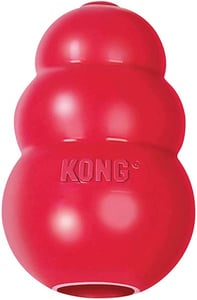 Rubber Chew Toys (Best for Inhalers, Destroyers, and Nibblers)
Rubber Chew Toys (Best for Inhalers, Destroyers, and Nibblers)
So long as they’re not too flimsy, rubber chew toys often represent the safest options for many dogs. The best rubber chew toys are those that are firm enough to stand up to serious chewing yet have enough “give” so they don’t cause tooth damage. The most popular rubber dog chew toy is the KONG Classic, which many dog owners are very familiar with and may already have at home.
Just make sure that the size of the toy is appropriate for your dog — the better toys come with a handy “size guide” on their packaging or on their website. Giving your dog a toy that's too small could lead to choking or intestinal obstructions, while too large could lead to excessive strain and damage to their jaw and chewing muscles. Over time, this can lead to osteoarthritis.
Some rubber toys have hollowed-out areas where you can hide treats or stuff with your dog’s favorite canned food or peanut butter. This can provide some much-needed mental stimulation for your dog and extend the time they spend playing with their toy, especially if you freeze the food-stuffed toy before giving it to them.
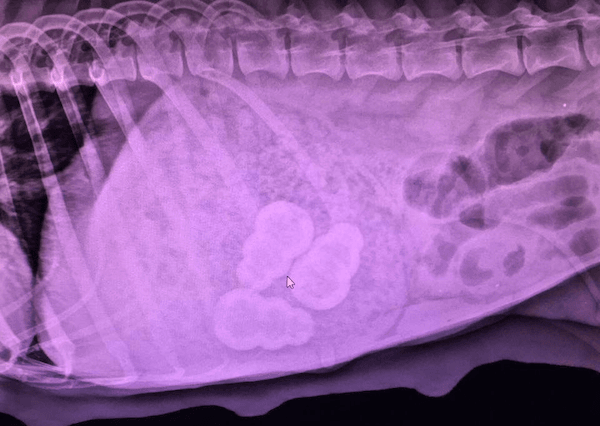
Size Matters: An important warning about choosing the correct size toys for your dogs, including when you have multiple dogs of different sizes. This photo above is an X-ray of a dog’s abdomen.The Kongs were originally meant for puppies but ended up swallowed by their mother. She had to be taken to surgery to have these three Kong toys removed from her stomach. She’s doing well — a lesson learned for everyone.
Our Top Pick
The Qwizl treat toy won the Best New Product award at the 2017 Global Pet Expo. Its manufacturer, West Paw, is B-Corp certified, which recognizes "companies all over the world that are creating exceptional positive social and environmental impact." Their proprietary Zogoflex® material is completely recyclable and free from latex, BPA, and phthalate. It's ideal for inserting treats, even bully sticks, which makes it take longer for your dog to finish the treat. Extra bonus for the Qwizl: it's dishwasher safe!
Silicone Chew Toys (Best for Nibblers, Gentle Chewers, and Average Chewers)
These toys are durable and pliable and do not cause damage to your dog’s teeth.
They are not designed for aggressive chewers, and supervision with these types of toys is necessary.
In choosing safe silicone toys, it is important to be aware that there are different grades of silicone.
Individual manufacturers can select/specify food-grade or medical-grade silicone. In order to have these designations for silicone, they must meet the standards of the U.S. Food and Drug Administration (FDA) and the U.S. Pharmacopeia (USP). This means they are safe and have a non-toxic composition.
If silicone is ordinary grade, it is typically only used for industrial purposes and isn’t used with food-related items.
There are a few easy ways to determine if the silica is food grade or ordinary grade:
-
Smell: If it smells, then it is not food grade. Food-grade silica has little odor.
-
Touch: Food-grade silica is smooth, very tough, and has elasticity. Ordinary silicone products are rough and deform easily.
-
Pull Test: Place one hand on either side of the object and pull hard. If the object turns white, it is ordinary silicone. It is food-grade silicone; there will be no white.
Additionally, be sure the toy is labeled as non-toxic, FDA-compliant, and free of any ‘known’ toxins (i.e., lead, BPA, phthalates, and more).
Yomp makes food-grade silicone dog toys. Here are a few of their chew toy options:
Find out how to safely clean and disinfect your dog's toys, even when they're not dishwasher safe.
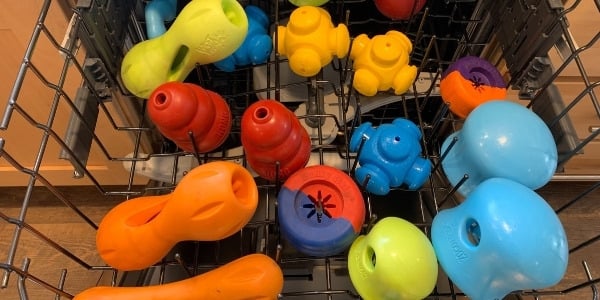
Edible Chews and Treats (Best for Destroyers and Nibblers)
Dental Chews
These chews — which include things like Greenies®, Dentastix™, Brushing Chews®, VeggieDent® Chews, and others — don’t last very long and, therefore, won't provide much long-term satisfaction for your dog’s chewing needs and desires. That said, they can provide some help with your dog’s short-term chewing desires and can even provide some help with their dental and oral health, as many of these chews can help minimize or slow plaque and/or tartar buildup. Just be aware that they can also add a fair number of calories to your dog’s diet and should only be given in moderation, especially to a dog with a weight problem.
Supervision is necessary to prevent your dog from choking on edible chews and treats. Throw the chew away when it gets small enough to be swallowed.
Our Top Pick
Whimzees are scientifically proven to help your dog’s oral health. They tend to last longer than many other similar brands. They contain no artificial colors, flavors, preservatives, or meat. This makes them a good option for dogs that have food intolerances or allergies.
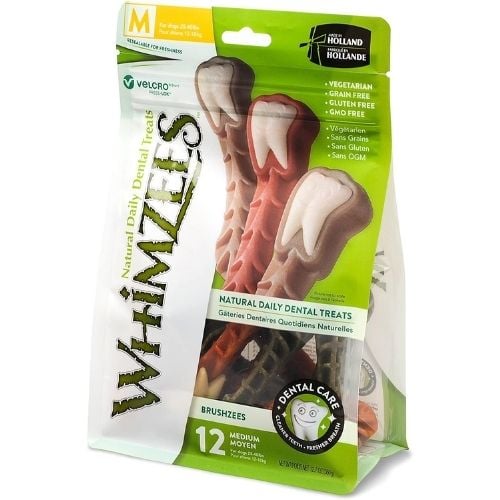
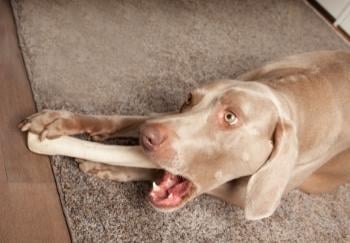
Rawhides
Available everywhere and relatively inexpensive, rawhides can be a good chew option for some dogs. If your dog actually chews the rawhide, rather than biting off and gulping large chunks, they’ll likely be OK — they may even get some teeth-cleaning benefits.
Are Rawhides Safe for Dogs?
Plenty of dogs chew rawhides without incident. However, some dogs end up with bits of rawhide lodged in their windpipe or stomach, causing choking or digestive obstruction.
Since they are hard to digest, they can cause gastrointestinal issues such as vomiting and diarrhea. Besides gastrointestinal issues, they can cause your dog to get pancreatitis. Sadly in some cases, especially if a dog has a prior history of pancreatitis, this event can be life-threatening.
Rawhides have also been found to cause significant irritation to the gums. This can result in painful cuts that can become inflamed and infected.
Learn more about what to look for in rawhide chews for your dog and get rawhide alternative options in Safer Rawhide Chews for Dogs.
Our Top Pick
Virbac C.E.T. Enzymatic Oral Hygiene Chews contain no artificial coloring and are made from carefully selected hides. These chews also include a powerful and beneficial enzyme called glucose oxidase, which helps protect your dog's teeth by breaking down the sugars that disease-causing bacteria feed on. You can buy them online or get them from your veterinarian.
Bully Sticks
Many dog owners swear by bully stick chews, which can be stuffed into certain interactive toys (like the Qwizl above!) and provide hours of chewing distraction (though some dogs will polish one off in mere minutes!). Bully sticks can be an okay chew treat for your dog, it just depends on how many you give, your dog’s chewsonality, and how sterile the sticks are.
Remember step one of choosing a quality chew toy? Apply the thumbnail test — if the chew doesn't “give” a little bit when you press it with your thumbnail, then it's too hard for your dog and could break their teeth. Some edible chews are too hard and can crack your dog's teeth (such as antlers and bones). Avoid anything that is harder than your dog's teeth to help prevent tooth fracture.
Are Bully Sticks Safe for Dogs?
Bully sticks can be a potential choke hazard and cause an intestinal obstruction. Be sure to monitor your pet closely as the stick gets smaller. Once they are no longer able to hold the stick between their paws to chew it, take it away. A great option for making bully sticks a safer chew activity is to use a quality bully stick holder.
Bully sticks contain a lot of calories and can cause an upset stomach, so don’t give too many too often, and as with all edible chews, make sure to wash your hands after handling them since they may be contaminated with bacteria.
Our Top Pick
Odor-free bully sticks are the way to go — otherwise, bully sticks can get pretty stinky! Barkworthies offers lots of different sizes and shapes of bully sticks. We love their 5-pack 12" odor-free classic bully stick version.
Rope Toys, Stuffed Toys, and Balls
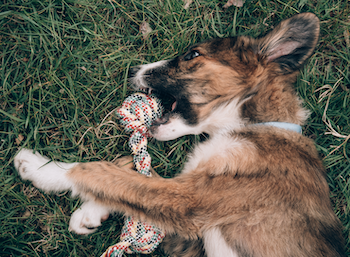
Ropes (Best for Play between Dogs & Humans)
Rope toys are generally safe for the right types of chewers. If you let your dog chew on a rope toy, never let them do so without observation, never leave it laying around, and always take it away if you see the dog pulling out and eating the strands. If they swallow these strands, it can lead to a dangerous digestive obstruction that requires surgery and can be fatal. Like with most chews and toys, please supervise your pup!
Are Rope Toys Safe for Dogs?
The strings from rope toys can get caught between your dog's teeth and up under their tongue. This can cause the rope to cut into the delicate tissue under the tongue. Also, these string remains can get caught between the teeth, hair, and other particles can accumulate, causing damage and infection to the gums.
If the rope toy is damaged and your dog is able to swallow some of the strands of string, they are at risk of developing a linear foreign body. What happens is some of the string remains in the stomach, and part of it passes into the intestines. The string then pulls the intestines in a way that cinches the intestines together as the gastrointestinal tract tries to pass the string. As the intestines continue to bunch up, tighter and tighter, the blood flow is cut off, and lacerations are cut into the intestines. As you can imagine, this is very painful.
Even if only a small piece of string from the rope toy is swallowed, small amounts of hair can accumulate on it and cause an intestinal blockage. Again, be very careful if letting your dog play with rope toys. They're better as tug toys for playing tug-o-war with you instead of as a chew toy option.
Our Top Tug Toy Pick
If tug of war is your game and that’s what you’re looking to use a rope toy for, there's actually a safer option called the Bumi Zogoflex Tug Toy. It's also ideal for two dogs to play together. As with all Zogoflex toys, they're non-toxic and dishwasher-safe.
Stuffed Toys (Best for Inhalers or Nibblers)
Some dogs just LOVE their stuffed toys! Having something soft to nibble on can be soothing to your dog, while others spend lots of time just trying to figure out how to get to all that stuffing inside. There are lots of options for stuffed toys: with squeakers or without, different levels of ‘toughness,’ and a variety of fabric textures.
Beware of poor-quality and cheaply constructed stuffed toys so the covering, squeakers, or stuffing doesn't wind up in your dog's intestines. The same caution applies to any toys that have buttons, eyes, bells, ribbons, strings, and any dangly bits. Regardless of what type of "stuffie" you get your dog, be sure to take it away and either fix it or throw it away if your dog manages to start "gutting" it.
Our Top Pick
Tuffy Dog Toys come in many playful styles, shapes, and sizes. Touted as the "world's tuff-est soft dog toy," these toys can usually stand up to some pretty good chewing and games of tug of war. There's a variety of Tuffy Toys to choose from, ranked in terms of their "tuff-ness" and ability to withstand chewing and rough play.
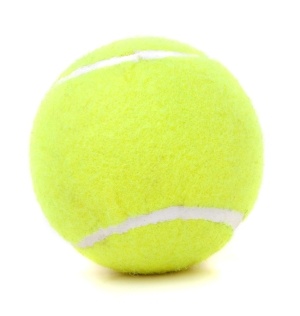 Balls (Best for Inhalers or Nibblers)
Balls (Best for Inhalers or Nibblers)
A dog with a tennis ball is so classic it’s practically a cliché. And lots of dogs do love to fetch and chew tennis balls … and do so safely!
Just like with any toy or chew, be sure that the size of the ball is appropriate for your pet. For smaller dogs, you want to use a ball with a diameter of 1.75 inches and for medium to large dogs, use a ball with a diameter of 2.5 inches.
Our Top Pick
We prefer rubber balls for dogs, like these Ultra Balls from Chuckit!, as the lack of felt material is a better option for your dog's teeth enamel. There are so many great fetch toys to pick from we couldn't just pick one! So we've made a list of our top 10 fetch toys other than tennis balls if you have a dog (big or small!) that loves to play fetch.
Are Tennis Balls Safe for Dogs?
When tennis balls are used appropriately with dogs, they are safe.
Just watch out that your dog doesn’t destroy and swallow pieces of their tennis balls, and check regularly to make sure the abrasive felt of the tennis ball isn’t wearing down the enamel on your dog’s teeth (this could expose the tooth root and pulp, necessitating a tooth extraction or root canal). Dogs that chronically carry balls in their mouth are at increased risk of these dental issues.
Also, be sure that you buy balls made from soft and good quality rubber. Normally, Grade A rubber is the best. Having a rubber that is too firm can cause unnecessary pressure on your dog’s jaw muscles and nerves. The irritation and inflammation from repeated use can lead to arthritis in their jaw. Also, recognize that, like any ball, a tennis ball can get stuck in your dog’s throat. Always use the correct size.
So you’ll be prepared should this ever happen; watch this brief video below showing how to do the Heimlich maneuver on a choking dog:
How to Make Chew Toys Last
Now that you have gone through all the effort to find the safest chews and toys for your dog, you want them to last. This is especially the case if you have a dog that is very particular about their toys. If you happen to have a dog that is peculiar about their toys, I highly recommend that if you discover a favorite toy, go out and buy several and put the extras away.
It never fails that after you find a favorite toy, that suddenly when you need to replace it they are not available. This horror happened to me. My poor pup was in love with one particular stuff toy. Well, for some odd reason, my other two dogs decided to destroy it one day. Mind you, they didn’t even bother with this particular toy. My dog was heartbroken. When I went to replace it, I couldn’t find another one. Then we were both sad. The moral of the story is to stock up on favorites!
- Hopefully, you are able to have several different types of toys and chews. If this is the case, try to rotate your dog’s toys weekly. There may be a favorite one or two you leave out all the time, but try to switch around the others.
- For your dog's mental enrichment, try having toys that serve different purposes. For example, one they like to carry, one that they like to chew, one that stimulates their brain, one that makes them be active, etc. Be sure to include toys that you can hide treats in. This will help stimulate your dog both mentally and physically but also lessening the desire of boredom chewing and wear and tear on other toys.
- Hide toys in different locations. We all know how excited our dogs get when they find a new toy!
- Find toys that you can use to interact with your dog. Not only do these toys help build a bond between you and your pet, but they will also last longer since you can control how they are played with.
- Avoid leaving chews outdoors. Variations in temperature and direct sun exposure can weaken the rubber, plastic, or nylon of the chew, making it susceptible to breaking.
Remember, there is not a one-size-fits-all chew or toy. All pets should have their toys carefully selected to suit their unique chewing style and environment. In addition to this, monitoring and regular toy maintenance are important.


